Motorized window treatments that can open and close on command, on a schedule, or even based on room occupancy are the ultimate finishing touch for any smart home. Like smart lighting, smart window treatments offer a host of benefits in terms of convenience, security, and energy conservation. There’s a safety angle, too: There are no pull cords that pose a strangulation risk to children and pets. But the wow factor they deliver also renders them a luxury item—even deploying them one room at a time can cost thousands of dollars if each room has a lot of windows.
We’re using the term “shades” in the headline above, but we’ll cover blinds here, too. What’s the difference? Shades are a soft window covering, typically made of fabric. They roll or pull up to allow light in, and they roll or drop down to block light and provide privacy. Blinds are a hard window treatment consisting of vertical or horizontal slats, typically made of wood, metal, plastic, or a composite material. The angle of these slats can be varied to admit or restrict light, or the slats can be closed tightly to block light and provide privacy. The slats in horizontal blinds can be pulled up in a stack to fully expose the window, while the slats in vertical blinds are pulled and gathered to the left or right for the same purpose.
Here are our top picks in several categories, followed by an explanation of the terms you’ll encounter and the features you should consider when you shop for smart shades or smart blinds. You’ll find a list of all the products we’ve reviewed in this category at the bottom of the page. It’s a relatively short list right now, but we’ll add new product reviews and additional product categories as time goes on.
Updated February 28, 2022 to add a link to our news story covering the new Lutron Serena Architectural Honeycomb Shade product line. These motorized shades feature a redesign top rail that reduces light creep. They’re available in 40 new fabrics.
Best cellular smart shades
Hunter Douglas’ Duette with PowerView motorization smart shades are elegant, sophisticated, and luxurious. These are top-down/bottom-up shades, which means they can open in both directions, a style that provides the ultimate in privacy and light control. And Hunter Douglas’ accessories—from its innovative “battery wand” power solution to its Pebble remote controls—are absolutely top shelf. They are not inexpensive, however, and there is no DIY option available.
Best cellular smart shades with a DIY option
These are beautiful shades, but being geeks, we’re particularly enamored with their battery compartment. The compartment is integrated into the headrail, so you need only tip it down to access and replace the batteries (D cells in the unit we reviewed). You’ll need to also buy an $80 Lutron Smart Bridge to connect the shades to your Wi-Fi network, since the shades rely on a proprietary wireless protocol, but Lutron’s app is very good and the bridge can also manage the company’s excellent Caséta smart lighting products (dimmers, switches, and smart plugs), ceiling-fan controllers, and it has hooks into third-party products, ranging from Ecobee smart thermostats to Sonos multi-room audio systems. Lutron’s product line is available either through dealers, who will handle installation, or direct to the DIYer.
Runner-up
Graber’s Virtual Cord cellular shades are every bit as pretty as Lutron’s, but their motors are slightly louder and their battery compartment needs to be removed from the headrail when you need to swap them out. They come with simple two-button remote controls, or you can spend extra to get more elaborate ones that can control multiple shades at the same time. These shades rely on Z-Wave technology, so you’ll need a bridge to connect them to your home Wi-Fi network. That can be Graber’s own Z-Wave bridge and app, or you can incorporate them into most any smart home system. Graber’s product line is available either through dealers, who will handle installation, or direct to the DIYer.
Best roller smart shades
We don’t have a lot of experience with this type of shade, yet, but we dig the Powershades TruePoE for its innovative means of integrating with a home network. Instead of relying on disposable batteries, the motor in these shades receives both electrical power and command-and-control messages over an ethernet cable (power over ethernet, or PoE). Having hardwired access to power makes the motor in these shades more than twice as fast as the battery-powered models we’ve reviewed. DIYers take note: Powershades does not sell direct to consumers; you’ll need to talk to a professional installer if you want one.
Best smart blinds
Blinds lend an elegant flair to a home, and motorizing them renders them supremely convenient. Serena by Lutron’s smart blinds are controlled by the same smart home hub you’ll use with its Caséta smart switches and dimmers, and there’s a follow-the-sun feature that automatically adjusts the tilt of the blinds’ slats to regulate the amount of light entering the room based on the sun’s location. On the downside, they can be very expensive, but a DIY option will save you some cash.
Shade types Shades can be divided into four broad categories: roller, Roman, cellular (aka honeycomb), and pleated. There are other types, but those are the most common. A roller shade operates just like it sounds: A motorized roller spins to unwind a sheet of fabric to cover your window, and the roller reverses direction to pull the sheet back onto the roller, exposing the window.
A Roman shade is also made from a single sheet of fabric (or other material, lined or unlined), but it opens as cords running through rings sewn into the back of the drapery-like fabric pull up and fold the fabric into a stack. To close, the cord is slowly unwound to drop and unfold the fabric.
Double-celled construction greatly increases a shades’ insulation value as well as its ability to block sunlight.
Cellular shades consist of multiple layers of fabric formed into honeycomb-like cells that trap air. Pleated shades are similar to cellular shades, but they’re fabricated from a single sheet of fabric and the pleats are typically much wider. Since they’re made of one sheet of fabric, the cords that lift the shade are exposed, whereas the cords in a cellular shade run through the middle of the cells and are therefore hidden. Both cellular and pleated shades raise and lower in an accordion-like fashion.
Blind types There are basically two types of blinds: Horizontal and vertical. The slats in a horizontal blind angle up and down to regulate light while vertical blinds twist left and right. The motors in these types of blinds might control only the angle of the slats, requiring the user to manually open or close them. This is particularly true of horizontal blinds since the cumulative weight of the slats can be substantial to pull up. Where shades are almost always made from fabric, blinds can be fabricated from host of materials, including wood, metal, plastic, and composites (faux wood).
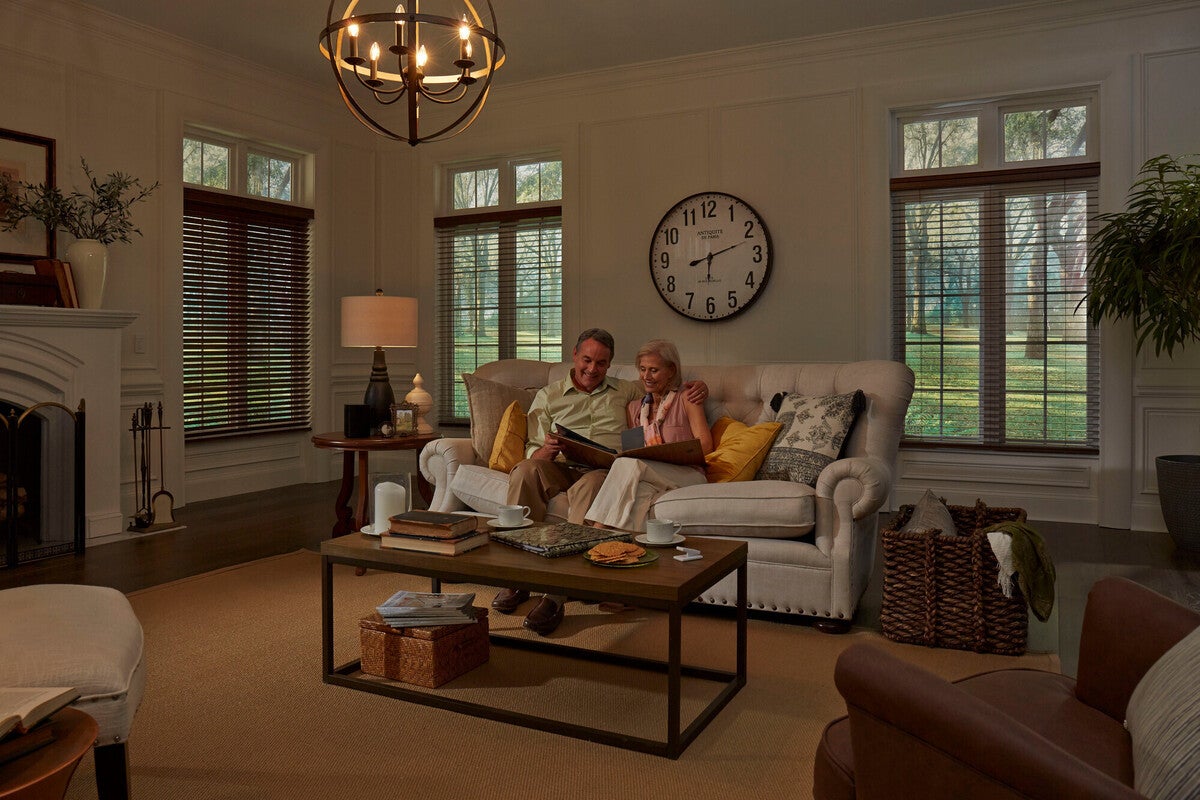
Wooden blinds are among the most elegant window treatments, but the motors in them might only adjust the angle of the slats, not lift and lower the entire shade.
Privacy and light control These considerations go hand in hand. The more light that passes through the shade or blind, the less privacy the window covering will provide. That said, the slats in blinds can be adjusted to let more light in while still providing strong privacy—at least when viewed from afar. A sheer shade will admit a lot of light, too, but it must be raised to admit the maximum amount of light, which exposes the window entirely. A room-darkening fabric will block the most amount of light and provides a great deal of privacy. The light-blocking properties of room-darkening shades make them a favorite for home theater installations.
Some shade manufacturers have introduced dual shades that lower a light-filtering fabric when you want lots of light and just a little privacy, and then drop a room-darkening fabric behind it when you want the most privacy and the least amount of light entering the room.
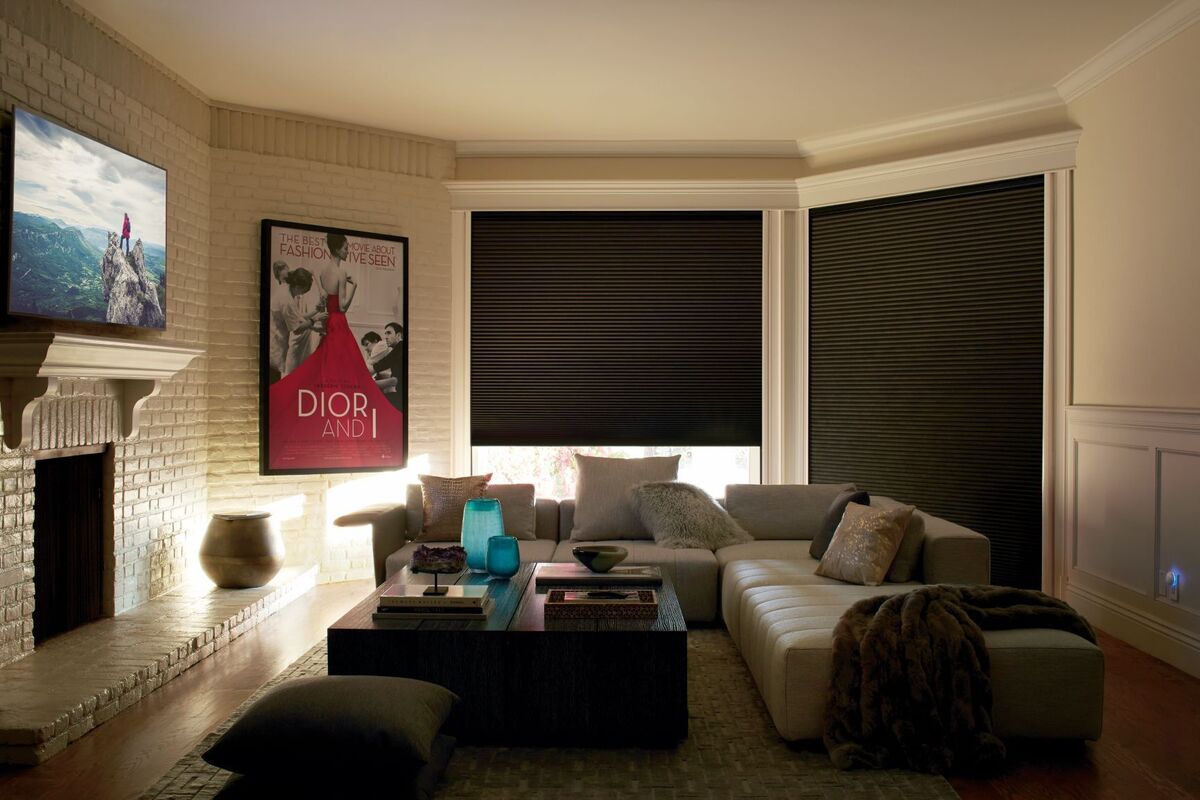
Cellular shades are the best choice for both light control and insulation, although they don’t necessarily need to be room-darkening shades like these.
Top-down/bottom-up shades—available in Roman, pleated, and honeycomb form factors—open and close from the top or bottom of the window. They can even move down from the top and up from the bottom to meet in the middle. These shades provide the best combination of light control and privacy, lowering to block views straight into the home while allowing the maximum amount of light to pass through the uncovered area(s) of the window.
Insulation value No matter the season, everyone enjoys a room filled with sunlight. But the U.S. Department of Energy estimates that 76 percent of the sunlight that falls on double-paned windows becomes heat inside the home, and that as much as 30 percent of a home’s heating energy is lost through its windows. If you’re not in the room anyway, closing the shades or blinds can save a tremendous amount of energy that would otherwise be consumed by your heating and air-conditioning appliances. And with smart shades, this can be accomplished automatically on a schedule, so the treatments are closed only during hours they’re exposed to direct sunlight, or even with a motion sensor that detects when the room is occupied and when it’s vacant.
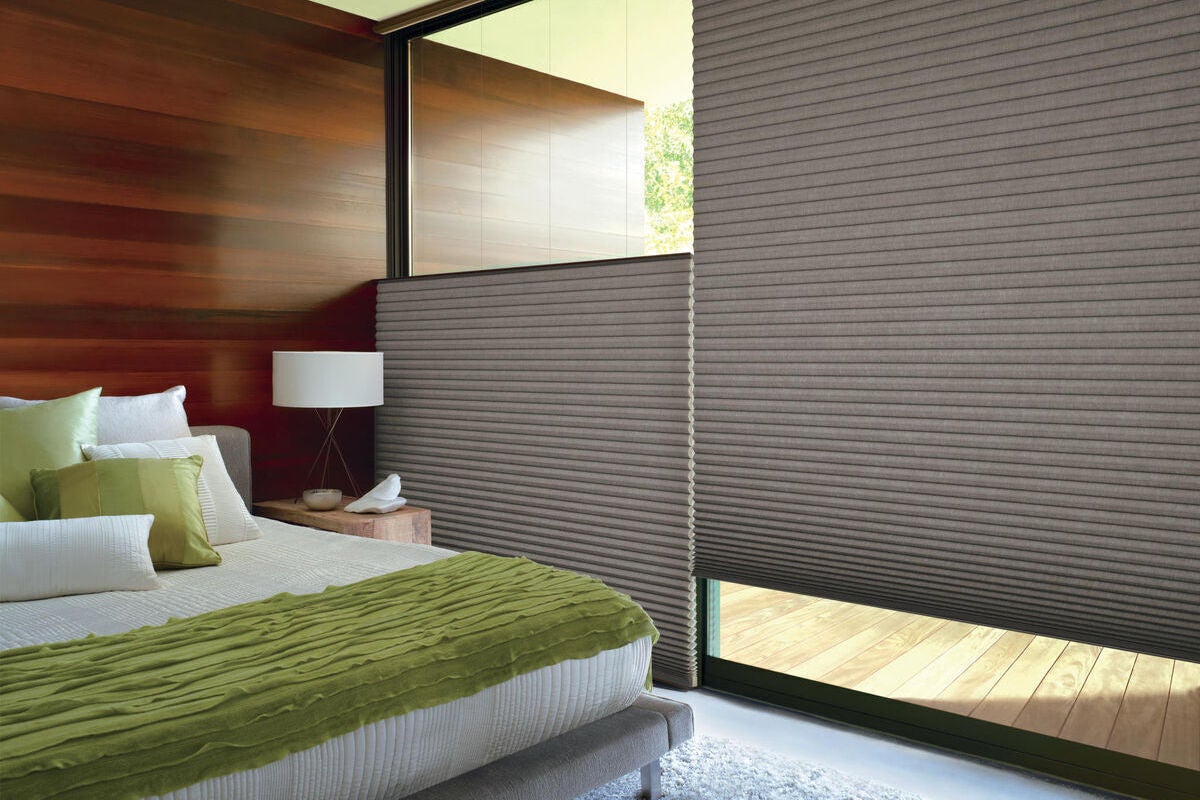
Top-down/bottom-up shades provide plenty of both light and privacy.
But some types of window coverings provide better insulation value than others, with cellular shades delivering the most energy savings. This is because their honeycomb-like cells trap air inside them and prevent heat conduction through the window glass. Some cellular shades are lined with foil or mylar to increase their R-value even more. The Department of Energy reports that in the winter, cellular shades can reduce heat loss through windows by as much as 40 percent. In the summer, this type of shade can reduce unwanted solar heat by up to 80 percent.
Roller and Roman shades are good at blocking light, but even models made from heavier fabrics have much lower R-values, according to the Department of Energy. Window blinds—both horizontal and vertical—are more effective at reducing heat gain in the summer than they are at keeping a room warm in the winter, according to the agency.
Power Motors need electrical power to operate, of course, but that electricity can come from several sources. Batteries are the most common solution, especially for retrofit installations. These are typically installed in a compartment that hangs from the back or is integrated into the headrail. Disposable batteries are the norm, but Hunter Douglas recently announced a rechargeable battery solution for its PowerView product line that’s compatible with both new and retrofit installations.
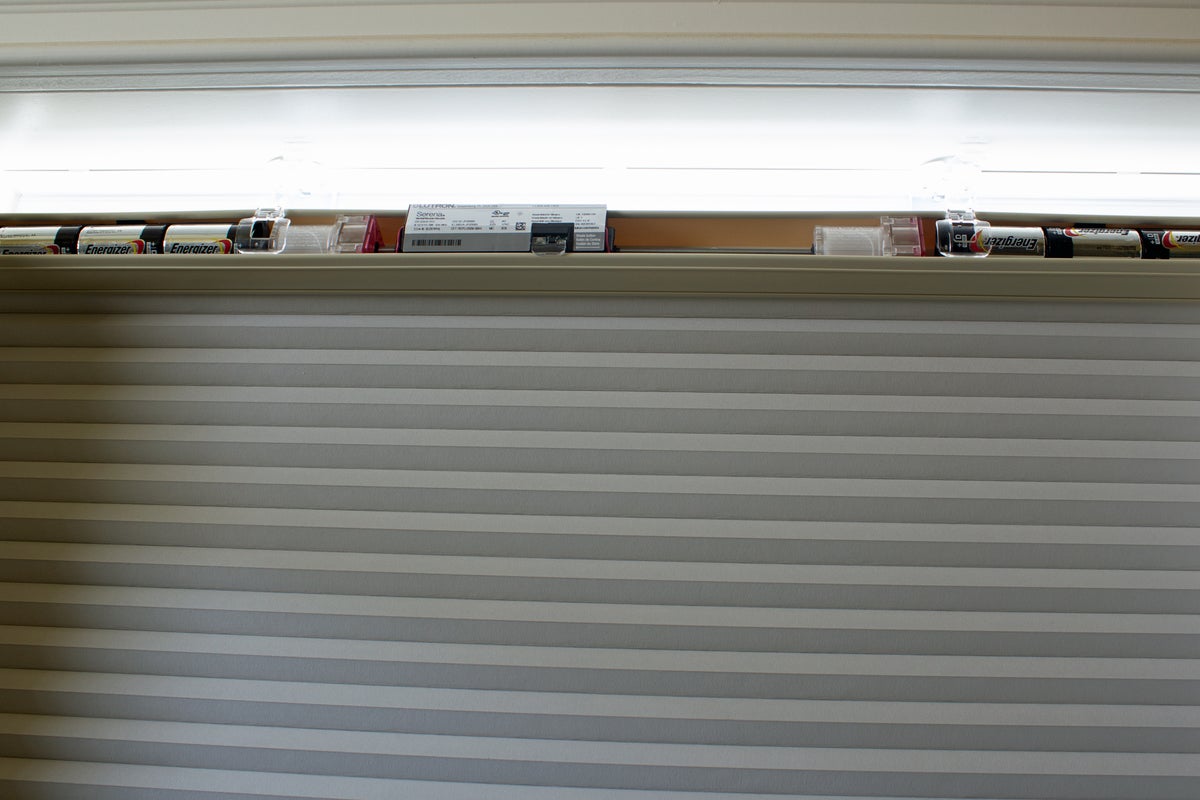
The Serena’s head rail drops down to expose its battery compartment.
The next most common power source is an AC adapter, but unless you have outlets embedded in your window frames, you’ll be left with power cords running down the window and over the sill. One novel alternative to batteries is Power over ethernet (PoE). We have reviewed a Powershades TruePoE roller shade and were impressed with the speed of its motor. With PoE shades, both electricity and command and control messages are sent over an ethernet cable connected to the shade’s motor. Ideally, you’ll want to install an RJ45 jack in the top of your window frame to plug the stub ethernet cable into, but you could also just drill a small hole in the top of the frame and fish a cable with a female RJ jack through it. Since PoE is a low-voltage technology, you won’t need to hire an electrician to do the cable run. You will, however, need to have a PoE ethernet switch plugged into your router.
Command and control Shades and blinds need more than a motor to be considered smart. They must also have a communications protocol to carry command and control messages. In the Powershades example mentioned above, messages are sent directly over an ethernet cable, but wireless solutions are much more common. Graber, for example, relies on Z-Wave technology for its Virtual Cord motorized shades, while Serena by Lutron shades use the same proprietary Clear Connect RF specification the company uses for its Caséta Wireless smart lighting and ceiling-fan controllers. Hunter Douglas also has its own proprietary wireless protocol, PowerView.
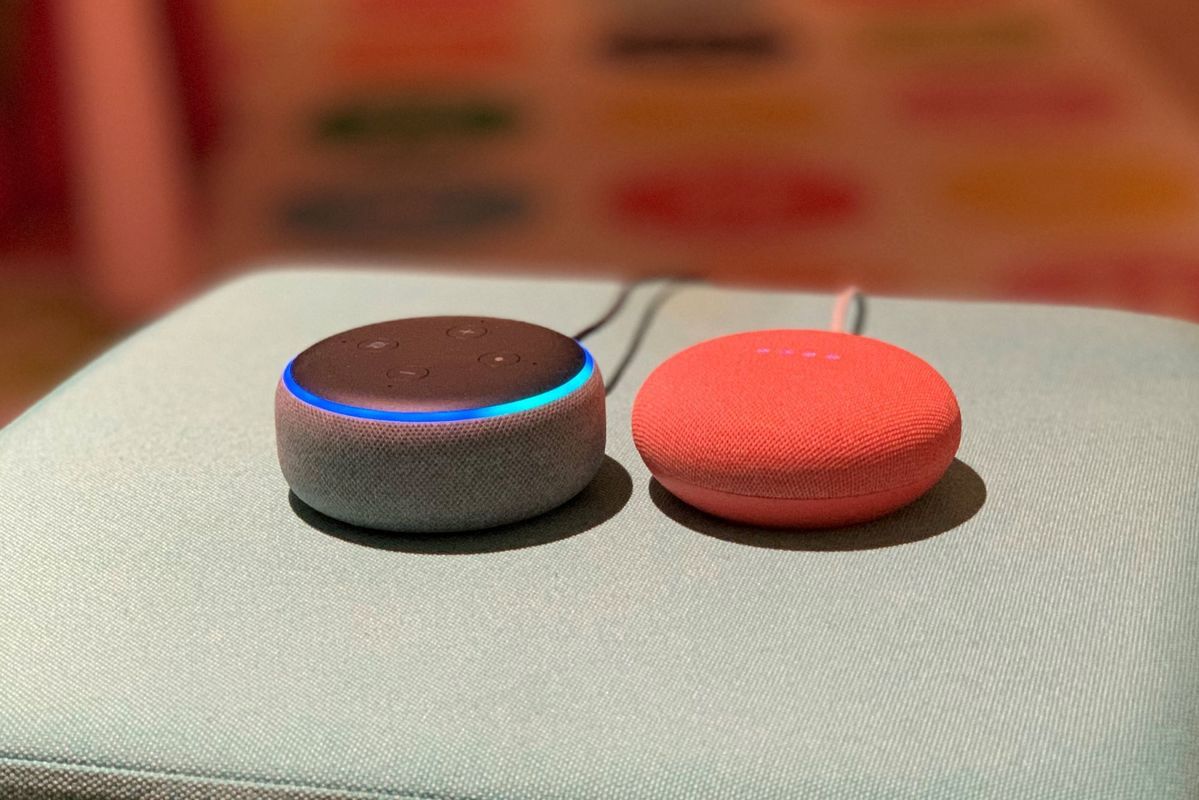
Amazon Echo and Nest Home smart speakers enable you to open and close your smart shades with voice commands.
Smart home integration There was a time when “proprietary” meant locking yourself into a given ecosystem—and forgoing cool new tech that other companies might come up with. That isn’t the case here. With the exception of the hardwired Powershades, all the wireless smart shades we’ve reviewed to date have required a bridge to connect the shades to your home Wi-Fi network (the Powershades are hardwired), but once on your network, motorized shades and blinds can be integrated into a broad range of smart home systems, both DIY and professionally installed.
With Z-Wave products, that bridge can be as simple as a USB dongle, like the one Graber offers for its Virtual Cord product line. Alternatively, you can incorporate the shades into a DIY Z-Wave-compatible smart home hub like Samsung’s SmartThings or a professionally installed smart home system such as the Vivint Smart Home system I used during my review. Serena by Lutron shades and blinds depend on Lutron’s Smart Bridge, but they can be further integrated into anything from a SmartThings system at the low end to a high-end Savant, Control4, or Elan smart home system. Hunter Douglas shades require a PowerView hub to connect to your network, but they can be incorporated into a broad range of higher-end smart home systems including Savant, Control4, and Crestron (SmartThings integration is not currently supported).
And with smart speakers and smart displays becoming so ubiquitous, smart shade makers would be crazy to not support at least Amazon Alexa and Google Assistant. HomeKit is a little less prevalent in the smart home, but it shouldn’t be dismissed. And all the products we’ve reviewed to date are in fact compatible with Amazon Echo and Google Home smart speakers and displays. Indeed, a smart speaker or smart display might be all you need to build out your own smart home system. But that’s a bigger topic for a different story.
Our smart shade reviews
Michael is TechHive’s lead editor. He built his own smart home in 2007 and used it as a real-world test lab when reviewing new products. Following a relocation, he is in the process of converting his new home, an 1890 bungalow, into a modern smart home.

